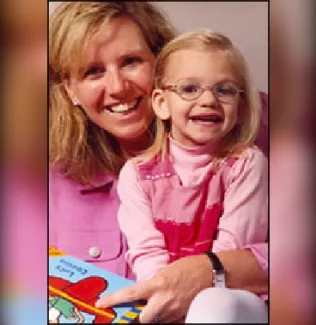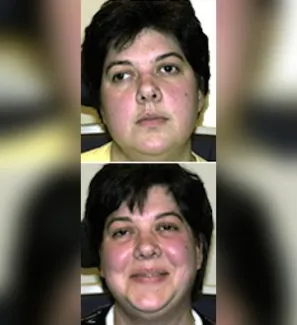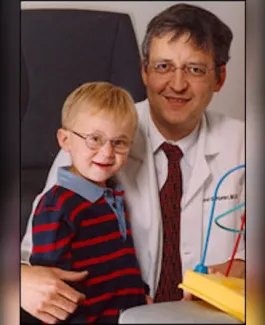Vision Therapy | In Depth
Though all parents hope for their children to have perfect eyesight, vision problems are quite common among kids: they affect about one in 20 preschoolers and one in four school-age children, according to the National Commission on Vision and Health. Many of these youngsters simply need corrective aids, like eyeglasses and contact lenses. A few may need eye surgery for a more serious issue.
But for children with certain kinds of eye problems, vision therapy may provide another treatment option. Unlike glasses or surgery, it aims to “teach” the visual system to work more efficiently through a series of supervised exercises. At Children’s Hospital Boston, we may prescribe vision therapy for children (and some adults, too) who have one or more of the following:
- tracking problems, also called oculomotor problems. These are difficulties with controlling eye movement, and revolve around three key skills:
- Fixation refers to the ability to continue looking at a stationary target.
- Pursuits refers to the ability to continue looking at a moving target.
- Saccades refers to the ability to smoothly change fixation quickly and accurately from one target to another (saccades are especially important in reading, for example).
- teaming problems, also called vergence problems. This means the eyes aren’t working in coordination with each other. A common example is convergence insufficiency, which is when the eyes don’t turn inward together when focusing on a nearby object.
- focusing problems, also called accommodative problems. Examples include difficulties in switching eye focus from far to near and trouble focusing the eyes during close work, like reading.

Saving Andie’s eyes
Seeing Andie Ormiston’s sparkling blue eyes and radiant smile, you'd never guess this petite 3-year-old’s entry into the world was touch-and-go. Learn how precise laser surgery at Boston Children’s Hospital saved Andie’s sight.
FAQ
Q: Is vision therapy the same thing as orthoptics?
A: While the two terms are sometimes used interchangeably, orthoptics refers to specific eye muscle exercises prescribed by an optometrist or orthoptist. Orthoptists, who often assist ophthalmologists, are trained to evaluate and measure eye alignment problems; they prescribe orthoptic exercises, but not other types of vision therapy.
Q: Are “pencil push-ups” part of vision therapy?
A: Easy to say and easy to remember, pencil push-ups are fairly well known as an exercise for convergence insufficiency. But although pencil push-ups may still be used as part of an overall vision therapy plan, there are often other, more effective (and less boring!) exercises for this vision problem.
Q: What are conditions are most commonly treated with vision therapy?
A: At Children’s Hospital Boston, most patients come to us for help with generaltracking problems (difficulties in controlling eye movement). We also see a lot ofintermittent exotropia (a type of strabismus in which one eye turns outward sometimes, but not always) and convergence insufficiency (a condition in which the eyes don't turn inward properly when focusing on a nearby object).
Q: At what age can children begin vision therapy?
A: Around age 6 or 7 is usually the soonest that vision therapy can begin. Younger children may also receive vision therapy, but it’s much harder for them to understand and comply with the process.
Q: How soon will vision therapy show results?
A: If a child sticks faithfully to the exercise plan, there should be improvement every week. Most children begin actually noticing a difference within six to eight weeks, about midway through the typical therapy program.
Q: Will my child’s vision problem come back later in life?
A: Generally speaking, children who successfully complete their vision therapy do not need further treatment. Studies are under way nationally to assess how well children maintain their skills after vision therapy for convergence insufficiency.

Giving Heather New Confidence
The day Heather Barlow came to Boston Children's Hospital for surgery to correct the misaligned eye (strabismus) she had lived with for a decade, it never occurred to her that she would be going home the same day with straight eyes.
Questions to ask your doctor
You and your family are key players in your child’s medical care. It’s important that you share your observations and ideas with your child’s health care provider and that you understand your provider’s recommendations.
If you are meeting with the doctor to discuss vision therapy for your child, you probably already have some ideas and questions on your mind. But at the appointment, it can be easy to forget the questions you wanted to ask. It’s often helpful to jot them down ahead of time so that you can leave the appointment feeling like you have the information you need. (If your child is old enough, you may want to suggest that she write down what she wants to ask her health care provider, too.)
Some of the questions you may want to ask include:
- What specific kind of vision problem does my child have?
- Is vision therapy the only option for treating this problem?
- How long will my child’s vision therapy program last?
- Does my child need both in-office and at-home therapy sessions?
- What can I do as a parent to help make the therapy program more successful?
- How can I tell if the therapy program is working?
- How many other children have you treated for this problem?
- What kind of success rate have you seen with them?
- How much will it cost?

Restoring Brennan's vision
Diagnosed with a cataract at 12 months, Brennan Hughes-Shiverick needed surgery to extract the clouded lens in his left eye. Brennan's ophthalmologist at a local hospital planned to remove the cataract, but didn't have the expertise to perform the implant — so Brennan's parents brought him to Boston Children's Hospital.
Vision Therapy | Tests & Diagnostics
Diagnosing vision problems
Regular eye exams offer an important safeguard for your child’s eye health. They can often spot early signs of disease, as well as test your child’s visual acuity (sharpness of vision). But they don’t test all aspects of vision, which means certain problems might go undetected until your child begins having symptoms. These may include:
- headache
- double vision
- rubbing or closing an eye
- eye strain/eye fatigue with close work (for example, reading, writing or computer work)
- blurry distance vision after prolonged close work
- losing place while reading
- re-reading lines and/or losing concentration when reading
- words or letters seem to “jump around” on the page
These symptoms are common in children who are referred for vision therapy. If your child’s doctor has ruled out other medical conditions and confirms normal eye exam results, he may refer your child to an optometrist who specializes in vision therapy.
A comprehensive eye exam with an optometrist can last up to an hour and includes a number of tests of eye teaming, focusing, eye movements, fine-motor and visual-motor and/or visual-perceptual skills. At the end of the exam, the optometrist will give you a detailed assessment of your child’s vision, and identify any problems that might benefit from vision therapy.
Vision Therapy | Treatments & Care
After identifying what kind of vision problem your child has, an optometrist specializing in vision therapy will design a personalized plan. The typical program combines hour-long office sessions with at-home exercises, and runs about three to four months. At that point, the optometrist will evaluate your child’s progress and see whether more therapy is needed.
There aren’t any authoritative statistics to give a sense of how successful vision therapy is overall, and much depends on the types of vision problems involved. On an individual level, though, children who can benefit from vision therapy are far more likely to show improvement if their parents help them stick with the exercise program and attend all follow-up visits.
Your child’s vision therapy program
The vision therapy specialist will design a series of exercises specifically for your child, and — depending on the vision problem at hand — incorporate a wide variety of equipment and activities. These include:
- Prisms, filters and lenses
- Paper-based charts and workbooks
- Computer programs
- A special bead-and-string device called a Brock string
Though vision therapy can be done at home as well as in the office, at Children’s Hospital Boston we believe combining the two (while emphasizing home therapy) is the best way to achieve the goals of treatment. A typical program is built on six one-hour office sessions, scheduled at three-week intervals. At each in-office session, your child will receive the instructions and materials she needs to practice exercises at home (about 20 to 30 minutes a day for at least five days a week).
Sticking to the exercise plan is a critical part of vision therapy. While the optometrist can give face-to-face encouragement during office sessions, it’s up to you and your child to keep that momentum going at home. Skipping exercise practice or cutting it short will only decrease the odds of real vision improvement.
During the final office session, the doctor will review the progress your child has made and determine whether more therapy is needed. If your child has followed the program carefully and developed the needed visual skills, she may receive a few exercises to do at home for “maintenance”—and then only come in for checkups after six months and one year.
Vision therapy and learning disabilities
Candidates for vision therapy often include children who are having trouble with reading or in school. But whether vision therapy helps treat bona fide learning disabilities is a hotly debated topic.
- Many optometrists (the health professionals who usually prescribe vision therapy) believe it can help children with dyslexia and other learning disabilities by treating related, underlying vision problems.
- On the other hand, many ophthalmologists (medical doctors who usually do not prescribe vision therapy) say there is no proof that correcting vision problems can reduce the severity of learning disabilities.
To help shed some light on the issue, Children’s Hospital Boston is planning studies on the effectiveness of vision therapy, especially with regard to vision and learning. In the meantime, it’s helpful for concerned parents to remember that vision is just one aspect of their child’s ability to read and learn. While it’s important to rule out vision problems in any child with learning disabilities, there are many other behavioral, cognitive and social factors at play.
Meet Jason, who came to Boston Children's — as an adult — for treatment of strabismus
After suffering a sudden stroke, 34-year-old Jason Crigler also experienced strabismus, a visual defect that occurs when one's eyes don't line up. Jason came to Children’s to see if he would be a good candidate for eye muscle surgery. He was — and in August 2007, he underwent surgery to realign both eyes.
Coping and support
In addition to the clinical information offered on this page, Children’s Hospital Boston has several other resources designed to give your family comfort, support and guidance:
- Boston Children’s Care for Children with Medical Complexity delivers essential medical care to children with birth defects, genetic disorders and other multifaceted health care needs. Call 617-355-6162 for more information.
- Our Behavioral Medicine Clinic helps children who are being treated on an outpatient basis at the hospital — as well as their families — understand and cope with their feelings about:
- Being sick
- Facing uncomfortable procedures
- Handling pain
- Taking medication
- Preparing for surgery
- Changes in friendships and family relationships
- Managing school while dealing with an illness
- Grief and loss
- Boston Children’s Psychiatry Consultation Service is comprised of expert and compassionate pediatric psychologists, psychiatrists, social workers and other mental health professionals who understand the unique circumstances of hospitalized children and their families. The team provides several services, including:
- Short-term therapy for children admitted to one of our inpatient units
- Parent and sibling consultations
- Teaching healthy coping skills for the whole family
- Educating members of the medical treatment team about the relationship between physical illness and psychological distress
- Boston Children’s Department of Psychiatry and Behavior Sciences offers a free booklet, “Helping Your Child with Medical Experiences: A Practical Parent Guide” (Adobe Acrobat is required). Topics in the booklet include:
- Talking to your child about her condition
- Preparing for surgery and hospitalization
- Supporting siblings
- Taking care of yourself during your child’s illness
- Adjusting to life after treatment
- Boston Children’s Hale Family Center for Families is dedicated to helping families locate the information and resources they need to better understand their child’s particular condition and take part in their care. All patients, families and health professionals are welcome to use the center’s services at no extra cost. The Center for Families is open Monday through Friday from 8 a.m. to 7 p.m., and on Saturdays from 9 a.m. to 1 p.m. Please call 617-355-6279 for more information.
- Global Services is a dedicated resource for patients and families from countries outside the United States. The center can provide assistance with everything from reviewing medical records to setting up appointments and locating lodging. Contact the center by phone at 01-617-355-5209 or via email at international.center@childrens.harvard.edu.
Helpful links
Please note that neither Boston Children’s Hospital nor the Department of Ophthalmology at Boston Children’s unreservedly endorses all of the information found at the sites listed below. These links are provided as a resource.
- American Optometric Association
- College of Optometrists in Vision Development
- E-Advisor: A Resource for Parents of Visually Impaired Children
- National Commission on Vision and Health
- National Eye Institute
Glossary of useful terms
- Accommodation: The ability of the eyes to focus on objects at different distances, to shift focus from near to far (and vice versa) and maintain focus at a fixed distance.
- Binocular: Of or involving both eyes at once.
- Convergence/divergence: The ability of the eyes to move inward together, to look at something close, and outward together, to look at something far.
- Convergence insufficiency: A condition in which the eyes don’t turn inward properly when focusing on a nearby object.
- Dyslexia: A learning disorder marked by trouble recognizing and comprehending written words.
- Exotropia: A type of strabismus in which one eye turns outward; sometimes known as “wall-eye.”
- Fixation: The ability of the eyes to look at a stationary target.
- Learning disability/learning disorder: A general term that can describe a variety of learning problems, most often trouble with reading, writing, listening, speaking, reasoning or doing math.
- Occlusion: A type of vision therapy that covers one eye, usually with a patch, to stimulate vision in the other.
- Occupational therapist: In a pediatric setting, a health professional who helps evaluate and treat children who have problems with coordination, perception, learning and/or behavior.
- Oculomotor: Having to do with eye movement.
- Ophthalmologist: A medical doctor (MD) who diagnoses and treats all diseases and disorders of the eye and can prescribe eyeglasses.
- Optometrist: A primary eye-care provider who prescribes eyeglasses, contact lenses, and low-vision devices, and diagnoses and treats certain conditions and diseases of the eye. Optometrists don’t perform surgeries. An optometrist who specializes in vision therapy is called a behavioral or developmental optometrist.
- Orthoptist: A health professional who, under the supervision of an ophthalmologist, tests and measures eye muscle alignment.
- Pursuit: The ability of the eyes to follow a moving target.
- Strabismus: A misalignment of the eyes.
- Saccades: The ability of the eyes to make a very quick, small movement from one visual target to another.
Vision Therapy | Research & Innovation
Though vision therapy is not a new treatment, many questions remain about what benefits it offers, and when and how it should be used. There has been a good deal of disagreement among professionals about its validity, and solid research findings are hard to come by.
One exception is a recent study funded by the National Eye Institute (NEI) and published in the journal Archives of Ophthalmology. Working at nine sites around the country, researchers held randomized, double-blind clinical trials using different types of vision therapy as the primary treatment for convergence insufficiency (CI) in children.
Over a period of 12 weeks, the researchers followed 221 children, ages 9 to 17, divided into four study groups:
- The first group did daily at-home pencil push-ups.
- The second group did at-home pencil push-ups and a series of computer-based vision exercises.
- The third group did an hour of in-office vision therapy each week, along with at-home reinforcement exercises.
- The fourth group was given “placebo” (simulated in order to gauge their perceived effects) vision activities designed to mimic office-based therapy.
At the end of the study, researchers found that:
- Office-based vision therapy was successful in 75 percent of patients (meaning their CI was fully corrected or had markedly improved)
- By comparison, the two at-home therapies were successful in roughly 40 percent of patients
This is one reason why we study vision therapy at Boston Children's Hospital.
Clinical trials
Boston Children’s doctors and scientists have made many breakthrough discoveries about diseases like polio and leukemia; our ongoing innovative research continues to push the boundaries of the way pediatric medicine is practiced.
It’s possible that your child will be eligible to participate in one of Boston Children’s current clinical trials. These studies are useful for a multitude of reasons: Some trials are designed to evaluate the effectiveness of a particular drug, treatment or therapy on a specific disease; others help doctors to better understand how and why certain conditions occur. At any given time, Children’s has hundreds of clinical trials under way.


